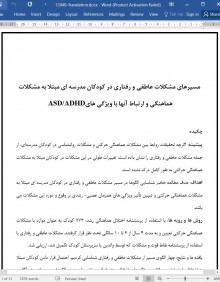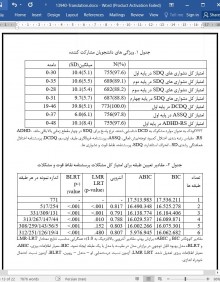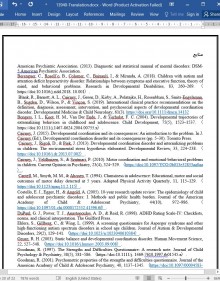
دانلود مقاله مسیرهای مشکلات عاطفی و رفتاری در کودکان مدرسه ای مبتلا به مشکلات هماهنگی
چکیده
پیشینه: اگرچه تحقیقات روابط بین مشکلات هماهنگی حرکتی و مشکلات روانشناسی در کودکان مدرسهای، از جمله مشکلات عاطفی و رفتاری را نشان داده است، تغییرات طولی در این مشکلات در کودکانِ مبتلا به مشکلات هماهنگی حرکتی به طور کامل درک نشده است.
اهداف: هدف مطالعه حاضر شناسایی الگوها در مسیر مشکلات عاطفی و رفتاری در کودکان مدرسه ای مبتلا به مشکلات هماهنگی حرکتی و تبیین تأثیر ویژگی های همزمان عصبی- رشدی بر وقوع و دوره این مشکلات می باشد.
روش ها و رویه ها: با استفاده از پرسشنامه اختلال هماهنگی رشد، 773 کودک به عنوان موارد با مشکلات هماهنگی حرکتی تعیین و به مدت 4 سال از 6 تا 10 سالگی تحت نظر قرار گرفتند. مشکلات عاطفی و رفتاری با استفاده از پرسشنامه نقاط قوت و مشکلات که توسط والدین یا سرپرستان کودک تکمیل شد، ارزیابی شد.
یافته ها و نتایج: چهار الگوی مسیر از مشکلات عاطفی و رفتاری شناسایی کردیم. احتمال قرار دادن کودکان مبتلا به اختلال طیف اوتیسم بالاتر و ویژگیهای اختلال بیش فعالی – نقص توجه، در الگوهای مسیر از پیش آگاهی دهنده ضعیف بیشتر است.
نتیجه گیری و کاربردها: یافتههای ما بر اهمیت ارزیابی مشکلات عاطفی و رفتاری و ویژگیهای همزمان عصبی- رشدی در کودکان مبتلا به مشکلات هماهنگی حرکتی در اوایل دوران ابتدایی تأکید میکند.
1. مقدمه
مشکلات هماهنگی حرکتی (مانند، افتادن یا برخورد با اشیا، کندی و عدم دقت در استفاده از ابزارهایی مانند قیچی، و مشکلات با دست خط یا دوچرخه سواری) اغلب در نمونه های جمعیت عمومی کودکان گزارش شده است(بلانک و همکاران، 2019) و شکل وخیم این مشکلات به عنوان نشانه های اصلی اختلال هماهنگی رشدی(DCD) طبقه بندی می شود (انجمن روانپزشکی آمریکایی ، 2013). شواهد زیادی نشان می دهد که بسیاری از کودکان مبتلا به DCD همچنان در طول دوران نوجوانی نیز مشکلات هماهنگی حرکتی را تجربه می کنند(کانتلر و همکاران، 1994؛ گوئز، 2003؛ لوس و همکاران، 1991). علاوه بر این، DCD غالبا همراه با سایر اختلالات عصبی- رشدی، مانند اختلال طیف اوتیسم(ASD) و اختلال بیش فعالی – نقص توجه(ADHD) روی می دهد( انجمن روانپزشکی آمریکا، 2013؛ بلانک و همکاران، 2019)
مشکلات هماهنگی حرکتی می تواند منجر به مشکلات هماهنگی غیرحرکتی نیز شود، مانند پیشرفت تحصیلی ضعیف، خودکارآمدی ضعیف و رضایت پایین از زندگی (بلانک و همکاران، 2019؛ کایرنی، 2015). تعدادی از مطالعات نشان دادهاند که کودکان مبتلا به DCD در معرض افزایش خطر مشکلات روانشناختی هستند که تأثیر منفی بر پیامدهای طولانیمدت دارد، مانند علائم افسردگی و اضطراب در نوجوانی و بزرگسالی (هیل و براون، 2013؛ سیگوردسون و همکاران،2002 ؛ زیکرت و همکاران، 2013). علاوه بر این، جریان تحقیقی نشان می دهد که مشکلات هماهنگی حرکتی در دوران کودکی می تواند مشکلات روانشناختی را در کودکان مدرسه ای، حتی در کودکان بدون تشخیص بالینی DCD ، پیش بینی کند (هیل و همکاران، 2016؛ کاتاگیری و همکاران، 2021؛ لینگام و همکاران .، 2012؛ پیک و همکاران، 2010). با این حال، اگرچه الگوهای زیادی در مسیرهای مشکلات عاطفی و رفتاری در یک نمونه جمعیت عمومی گزارش شده است(مالرانی و همکاران، 2020)، مطالعاتی که به دنبال مشکلات روانشناختی در کودکان مبتلا به DCD یا کودکان مبتلا به مشکلات حرکتی بودند، محدود است و هیچ مطالعه ای به بررسی الگوهای تغییرات طولی این مشکلات در این جمعیت نپرداخت. بنابراین، وقوع و سیر مشکلات روانشناختی در این جمعیت به طور کامل درک نشده است. شناسایی مسیرهای رشدی این مشکلات ممکن است برای شناسایی زیرگروه هایی از کودکان مبتلا به مشکلات هماهنگی حرکتی که به طور بالقوه می توانند از مداخلات روانشناختی زودهنگام بهره مند شوند، مفید باشد.
5. نتیجه گیری
با استفاده از داده هایی برگرفته از نظرسنجی اجتماع محور در مدرسه، الگوهای پنهان برای مسیرهای چالش های روانشناختی را در کودکان با مشکلات هماهنگی حرکتی شناسایی کردیم و تاثیر ویژگی های ASD و ADHD بر این مسیرها را تایید کردیم. یافته های ما بر نیاز به مداخله زودهنگام برای مشکلات عاطفی و رفتاری در زیرگروهی از کودکان با مشکلات زیاد روانشناختی در مدارس ابتدایی، با توجه به الگوی مسیر شدید در این زیرگروه، تاکید دارد. یافته ها ما بر اهمیت ارزیابی ویژگی های همزمان ASD و ADHD تاکید دارد. بررسی های بیشتر در یک طیف سنی گسترده تر با در نظر داشتن تاثیر دیگر عوامل، برای تایید نتایج حاضر، ضرورت خواهد داشت.
Abstract
Background Although research has demonstrated associations between motor coordination difficulties and psychological problems in school-age children, including emotional and behavioral problems, longitudinal changes in these problems in children with motor coordination difficulties are not fully understood.
Aims The current study aimed to identify patterns in the trajectory of emotional and behavioral problems in school-age children with motor coordination difficulties, and to elucidate the effect of co-existing neurodevelopmental traits on the occurrence and course of these problems.
Methods and procedures Using the Developmental Coordination Disorder Questionnaire, 773 children were defined as cases with motor coordination difficulties and followed for 4 years, from 6 to 10 years of age. Emotional and behavioral problems were assessed using the Strengths and Difficulties Questionnaire completed by children’s parents or guardians.
Outcomes and results We identified four trajectory patterns of emotional and behavioral problems. Children with higher autism spectrum disorder and attention deficit hyperactivity disorder traits were more likely to be assigned to poor prognostic trajectory patterns.
Conclusions and implications Our findings emphasize the importance of assessing emotional and behavioral problems and co-existing neurodevelopmental traits in children with motor coordination difficulties in early elementary school.
1. Introduction
Motor coordination difficulties (e.g., dropping or bumping into objects, slowness and inaccuracy in using tools such as scissors, and difficulties with handwriting or riding a bike) are frequently reported in community samples of children (Blank et al., 2019), and the severe form of these difficulties is classified as cardinal symptoms of developmental coordination disorder (DCD) (American Psychiatric Association, 2013). Increasing evidence suggests that many children with DCD continue to experience motor coordination difficulties throughout adolescence (Cantellet al., 1994; Geuze, 2003; Losse et al., 1991). Additionally, DCD frequently co-occurs with other neurodevelopmental disorders, such as autism spectrum disorder (ASD) and attention deficit hyperactivity disorder (ADHD) (American Psychiatric Association, 2013; Blank et al., 2019).
Motor coordination difficulties can also lead to non-motor coordination problems, including poor scholastic achievement, poor selfefficacy, and low life satisfaction (Blank et al., 2019; Cairney, 2015). A number of studies have suggested that children with DCD are at increased risk of psychological problems that negatively impact on long-term outcomes, such as symptoms of depression and anxiety in adolescence and adulthood (Hill & Brown, 2013; Sigurdsson et al., 2002; Zwickeret al., 2013). Furthermore, one line of research suggests that motor coordination difficulties in childhood could predict psychological problems in school-age children, even in children without a clinical diagnosis of DCD (Hill et al., 2016; Katagiri et al., 2021; Lingam et al., 2012; Piek et al., 2010). However, although several patterns in the trajectories of emotional and behavioral problems in a general population sample have been reported (Mulraney et al., 2020), studies have followed psychological problems in children with DCD or those with motor difficulties over time are limited, and no studies have examined the patterns of longitudinal changes of these problems in this population. Therefore, the occurrence and course of psychological problems in this population are not fully understood. Identifying the developmental trajectories of these problems may be helpful for detecting subgroups of children with motor coordination difficulties who could potentially benefit from early psychological interventions.
5. Conclusions
Using data from a prospective community-based school survey, we identified latent patterns for the trajectories of psychological challenges in children with motor coordination problems and confirmed the influence of ASD and ADHD traits on these trajectories. Our findings indicate the need for early intervention for emotional and behavioral problems in a subgroup of these children with elevated psychological problems in early elementary school, given the worsening trajectory pattern in this subgroup. Our findings also highlight the importance of assessing co-existing ASD and ADHD traits. Further investigations across a broader age range while considering the influence of other factors will be required to confirm the present results.
چکیده
آنچه این مقاله می افزاید؟
1. مقدمه
2. روش ها
2.1. زمینه مطالعه و مشارکت کنندگان
2.2. معیارها و رویه ها
2.3. تحلیل داده ها
3. یافته ها
4. بحث
5. نتیجه گیری
منابع
Abstract
What this paper adds?
1. Introduction
2. Methods
2.1. Study setting and participants
2.2. Measurements and procedure
2.3. Data analysis
3. Results
4. Discussion
5. Conclusions
Funding
CRediT authorship contribution statement
Declarations of interest
Acknowledgements
References
این محصول شامل پاورپوینت ترجمه نیز می باشد که پس از خرید قابل دانلود می باشد. پاورپوینت این مقاله حاوی 24 اسلاید و 5 فصل است. در صورت نیاز به ارائه مقاله در کنفرانس یا سمینار می توان از این فایل پاورپوینت استفاده کرد.
در این محصول، به همراه ترجمه کامل متن، یک فایل ورد ترجمه خلاصه نیز ارائه شده است. متن فارسی این مقاله در 9 صفحه (2400 کلمه) خلاصه شده و در داخل بسته قرار گرفته است.
علاوه بر ترجمه مقاله، یک فایل ورد نیز به این محصول اضافه شده است که در آن متن به صورت یک پاراگراف انگلیسی و یک پاراگراف فارسی درج شده است که باعث می شود به راحتی قادر به تشخیص ترجمه هر بخش از مقاله و مطالعه آن باشید. این فایل برای یادگیری و مطالعه همزمان متن انگلیسی و فارسی بسیار مفید می باشد.
بخش مهم دیگری از این محصول لغت نامه یا اصطلاحات تخصصی می باشد که در آن تعداد 50 عبارت و اصطلاح تخصصی استفاده شده در این مقاله در یک فایل اکسل جمع آوری شده است. در این فایل اصطلاحات انگلیسی (تک کلمه ای یا چند کلمه ای) در یک ستون و ترجمه آنها در ستون دیگر درج شده است که در صورت نیاز می توان به راحتی از این عبارات استفاده کرد.
- ترجمه فارسی مقاله با فرمت ورد (word) با قابلیت ویرایش و pdf بدون آرم سایت ای ترجمه
- پاورپوینت فارسی با فرمت pptx
- خلاصه فارسی با فرمت ورد (word)
- متن پاراگراف به پاراگراف انگلیسی و فارسی با فرمت ورد (word)
- اصطلاحات تخصصی با فرمت اکسل



